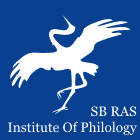 |
|
||||||||||||
|
Institute of Philology of
the Siberian Branch of Russian Academy of Sciences |
|
||||||||||||
|
|||||||||||||
|
DOI: 10.25205/2312-6337 Roskomnadzor certificate number Эл № ФС 77-84783
| |
| Yazyki i Fol’klor Korennykh Narodov Sibiri (Languages and Folklore of Indigenous Peoples of Siberia) | |
|
ArticleName: On the origin of the instrumental case marker in the Manchu-Tungusic languages Authors: A. M. Pevnov Institute for Linguistic Studies of the RAS, Saint Petersburg, Russian Federation In the section История языка
Abstract: Grammaticalization processes may account for at least three case markers in Manchu-Tungusic languages. One of these is the instrumental case marker, likely derived from the proto-language form *-gī. The reflexes of this reconstructed affix can be found in Jurchen and modern Manchu-Tungusic languages (-gi, -i, -ǯī, -ǯi, -č, -t). The sporadic palatalization of g before i occurred in the Manchu-Tungusic proto-language and its descendants. In Jurchen, which written documents date back to the 12th–15th centuries, the marker of the in-strumental case was -gi. In Manchu, the instrumental case marker is identical to the genitive case marker -i. The author supposes that the former goes back to *-gī (> -gi > *-γi > *-ji > -i), whereas the latter derives from the proto-language form *-(j)i ~ -ni. Notably, the instrumental case marker has been preserved in its original form in at least one Manchu word: əmgi ‘together՚ ( side՚. The meaning ‘the other of two > side՚ is close to the meaning ‘opposite՚, which was one of the meanings of the Old English wið (it corresponds to the modern preposition with). Apparently, in the Manchu-Tungusic proto-language the case marker *-gī had originally the comitative meaning, which quite naturally developed from the meaning ‘the other of two > side՚. It is noteworthy that the comitative meaning is characteristic of modern instrumental case markers in several Manchu-Tungusic languages. Keywords: instrumental case, affix, grammaticalization, the Manchu-Tungusic languages, proto-language, etymology Bibliography: Avrorin V. A. Grammatika nanayskogo yazyka. T. 1. Foneticheskoye vvedeniye i morfologiya imennykh chastey rechi [Grammar of the Nanay language. Vol. 1. Phonetic introduction and morphology of the nominal parts of speech]. Moscow, Leningrad, Publishing House of the Academy of Sciences of the USSR, 1959, 282 p. (In Russ.) Avrorin V. A. Grammatika man’chzhurskogo pis’mennogo yazyka [Grammar of the Manchu written language]. St. Petersburg, Nauka, 2000, 239 p. (In Russ.) Avrorin V. A., Lebedeva Ye. P. Orochskiye teksty i slovar’ [Oroch texts and dictionary]. Leningrad, Nauka, 1978, 264 p. (In Russ.) Benzing J. Die tungusischen Sprachen.Versuch einer vergleichenden Grammatik. Wiesbaden, Verlag der Akademie der Wissenschaften und der Literatur in Mainz, in Kommission bei Franz Steiner Verlag GMBH, 1956, 154 p. Evenkiysko-russkiy slovar’ [Ewenki-Russian dictionary]. Vasilevich G. M. (Comp.). Moscow, State Publishing House of Foreign and National Dictionaries, 1958, 802 p. (In Russ.) Golovachev V. Ts., Ivliyev A. L., Pevnov A. M., Rykin P. O. Tyrskiye stely XV veka: Perevod, kommentarii, issledovaniye kitayskikh, mongol’skogo i chzhurchzhen’skogo tekstov [The Tyr stelae of the 15th century: translation, commentary, research of Chinese, Mongol, and Jurchen texts]. St. Petersburg, Nauka, 2011, 318 p. (In Russ.) Ikegami J. A Dictionary of the Uilta Language Spoken on Sakhalin. Sapporo, Hokkaido University Press, 1997, 294 p. Janhunen J. Material on Manchurian Khamnigan Evenki. Helsinki (published by the Castrenianum Complex of the University of Helsinki in cooperation with the Finno-Ugrian Society), 1991, 120 p. Kane D. The Sino-Jurchen Vocabulary of the Bureau of Interpreters. Bloomington, Indiana University, Research Institute for Inner Asian Studies, 1989, 461 p. Khasanova M., Pevnov A. Mify i skazki negidal’tsev [Myths and tales of the Negidals]. Osaka, Osaka Gakuin University, 2003, 297 p. M. Alexander Castrén’s Grundzüge einer tungusischen Sprachlehre nebst kurzem Wörterverzeichniss. Anton Schiefner (Ed.). St. Petersburg, 1856, 140 p. Mongolian-English Dictionary. Ferdinand D. Lessing (Ed.), Mattai Haltod, John Gombojab Hangin, Serge Kassatkin, and Ferdinand D. Lessing (Comps.). Berkeley and Los Angeles, University of California Press, 1960, 1217 p. Onenko S. N. Nanaysko-russkiy slovar’ [Nanay-Russian dictionary]. Moscow, Rus. yaz., 1980, 552 p. (In Russ.) Pevnov A. M. Chteniye chzhurchzhen’skikh pis’myon [Reading of the Jurchen script]. St. Petersburg, Nauka, 2004, 498 p. (In Russ.) Pevnov A. M. O mongol’skom vliyanii na vyrazheniye nekotorykh padezhnykh znacheniy v tunguso-man’chzhurskikh yazykakh [Mongolic influence on the marking of certain cases in the Manchu-Tungusic languages]. In: Acta Linguistica Petropolitana. Trudy Instituta lingvisticheskikh issledovaniy [Acta Linguistica Petropolitana. Proceedings of the Institute for Linguistic Studies]. St. Petersburg, Nauka, 2015, vol. XI, pt. 3, pp. 303‒328. (In Russ.) Polnyy man’chzhursko-russkiy slovar’, sostavlennyy prepodavatelem man’chzhurskogo yazyka pri Imperatorskom S.-Peterburgskom universitete, deystvitel’nym stat. sovetn. Ivanom Zakharovym [Comprehensive Manchu-Russian dictionary, compiled by Ivan Zakharov, teacher of the Manchu language at the Imperial St. Petersburg University, State Councillor]. Zakharov I. (Comp.). St. Petersburg, Tip. Imp. Akad. nauk, 1875, 1127 p. (In Russ.) Poppe N. N. Materialy po solonskomu yazyku [Materials on the Solon language]. Leningrad, Publishing House of the Academy of Sciences of the USSR, 1931, 143 p. (In Russ.) Rudnev A. Novyye dannyye po zhivoy man’chzhurskoy rechi i shamanstvu (s dvumya risunkami v tekste) [New Data on the Live Manchu Speech and Shamanism (with two drawings in the text)]. In: Zapiski Vostochnogo Otdeleniya Imperatorskogo Russkogo Arkheologicheskogo Obshchestva [The Notes of the Eastern Division of the Imperial Russian Archaeological Society]. St. Petersburg, 1912, vol. XXI, iss. I, pp. 47‒115. (In Russ.) Sravnitel’nyy slovar’ tunguso-man’chzhurskikh yazykov. Materialy k etimologicheskomu slovaryu [Comparative dictionary of the Manchu-Tungusic languages. Materials for etymological dictionary]. V. I. Tsintsius (Ed.). Leningrad, Nauka, 1975, vol. I, 672 p. (In Russ.) Sunik O. P. Ul’chskiy yazyk. Issledovaniya i materialy [The Ulcha language. Researches and materials]. Leningrad, Nauka, 1985, 263 p. (In Russ.) Whaley L. J. Orochen. In: The Tungusic Languages. Alexander Vovin, José Andrés Alonso de la Fuente and Juha Janhunen (Eds.). Routledge Language Family Series. London and New York, Routledge, 2024, pp. 184‒205. Zikmundová V., Gao Wa. Spoken Manchu. In: The Tungusic Languages. Alexander Vovin, José Andrés Alonso de la Fuente and Juha Janhunen (Eds.). Routledge Language Family Series. London and New York, Routledge, 2024, pp. 463‒482. Zikmundová V. Sibe. In: The Tungusic Languages. Alexander Vovin, José Andrés Alonso de la Fuente and Juha Janhunen (Eds.). Routledge Language Family Series. London and New York, Routledge, 2024, pp. 483‒500. |
 |
ИФЛ СО РАН 630090, Новосибирск, ул. Николаева, 8 тел./факс: 8-(383)330-15-18, ifl@philology.nsc.ru |
Карта сайта Дизайн © ИФЛ СО РАН |


